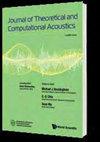Pseudospectral Time-Domain (PSTD) Methods for the Wave Equation: Realizing Boundary Conditions with Discrete Sine and Cosine Transforms
IF 1
3区 物理与天体物理
Q3 ACOUSTICS
Journal of Theoretical and Computational Acoustics
Pub Date : 2020-05-01
DOI:10.1142/s2591728520500218
引用次数: 1
Abstract
Pseudospectral time domain (PSTD) methods are widely used in many branches of acoustics for the numerical solution of the wave equation, including biomedical ultrasound and seismology. The use of the Fourier collocation spectral method in particular has many computational advantages. However, the use of a discrete Fourier basis is also inherently restricted to solving problems with periodic boundary conditions. Here, a family of spectral collocation methods based on the use of a sine or cosine basis is described. These retain the computational advantages of the Fourier collocation method but instead allow homogeneous Dirichlet (sound-soft) and Neumann (sound-hard) boundary conditions to be imposed. The basis function weights are computed numerically using the discrete sine and cosine transforms, which can be implemented using [Formula: see text] operations analogous to the fast Fourier transform. Practical details of how to implement spectral methods using discrete sine and cosine transforms are provided. The technique is then illustrated through the solution of the wave equation in a rectangular domain subject to different combinations of boundary conditions. The extension to boundaries with arbitrary real reflection coefficients or boundaries that are nonreflecting is also demonstrated using the weighted summation of the solutions with Dirichlet and Neumann boundary conditions.波动方程的伪谱时域方法:用离散正弦和余弦变换实现边界条件
伪谱时域(PSTD)方法广泛应用于声学的许多分支,包括生物医学超声和地震学,用于波方程的数值解。特别是使用傅里叶搭配谱法具有许多计算上的优点。然而,离散傅里叶基的使用也固有地局限于求解具有周期边界条件的问题。在这里,描述了基于使用正弦或余弦基的一系列频谱搭配方法。这些保留了傅里叶配置方法的计算优势,但允许施加齐次狄利克雷(音-软)和诺伊曼(音-硬)边界条件。基函数的权重是用离散正弦和余弦变换来计算的,这可以用类似于快速傅里叶变换的运算来实现。实用的细节如何实现频谱方法使用离散正弦和余弦变换提供。然后通过在不同边界条件组合下的矩形域中求解波动方程来说明该技术。利用Dirichlet和Neumann边界条件下的加权求和,证明了对任意实反射系数边界或非反射边界的扩展。
本文章由计算机程序翻译,如有差异,请以英文原文为准。
求助全文
约1分钟内获得全文
求助全文
来源期刊

Journal of Theoretical and Computational Acoustics
Computer Science-Computer Science Applications
CiteScore
2.90
自引率
42.10%
发文量
26
期刊介绍:
The aim of this journal is to provide an international forum for the dissemination of the state-of-the-art information in the field of Computational Acoustics.
Topics covered by this journal include research and tutorial contributions in OCEAN ACOUSTICS (a subject of active research in relation with sonar detection and the design of noiseless ships), SEISMO-ACOUSTICS (of concern to earthquake science and engineering, and also to those doing underground prospection like searching for petroleum), AEROACOUSTICS (which includes the analysis of noise created by aircraft), COMPUTATIONAL METHODS, and SUPERCOMPUTING. In addition to the traditional issues and problems in computational methods, the journal also considers theoretical research acoustics papers which lead to large-scale scientific computations.
 求助内容:
求助内容: 应助结果提醒方式:
应助结果提醒方式:


